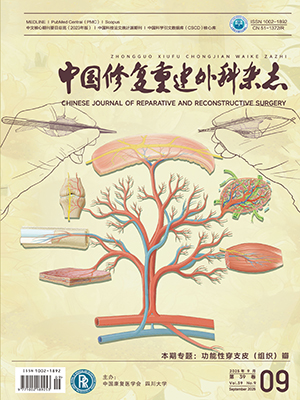Objective To explore the in vitrodifferentiation of the rat mesenchymal stem cells (MSCs ) into the skeletal muscle cells induced by the myoblast differentiation factor (MyoD) and 5-azacytidine. Methods The MSCs were taken from the rat bone marrow and the suspension of MSCs was made and cultured in the homeothermia incubator which contained 5% CO2at 37℃. The cells were observed under the inverted phase contrast microscope daily. The cells spreading all the bottom of the culture bottle were defined as onepassage. The differentiation of the 3rd passage of MSCs was induced by the combination of 5-azacytidine, MyoD, transforming growth factor β1, and the insulin like growth factor 1. Nine days after the induction, the induced MSCs were collected, which were analyzed with the MTT chromatometry, theflow cytometry, and the immunohistochemistry. Results The primarily cultured MSCs grew as a colony on the walls of the culture bottle; after the culture for 5-7 days, the cells were shaped like the fibroblasts, the big flat polygonal cells, the medium sized polygonal cells, and the small triangle cells; after the culture for 12 days, the cells were found to be fused, spreadingall over the bottle bottom, but MSCs were unchanged too much in shape. After the induction by 5-azacytidine, some of the cells died, and the cells grew slowly. However, after the culture for 7 days, the cells grew remarkably, the cell volume increased gradually in a form of ellipse, fusiform or irregularity. After theculture for 14 days, the proliferated fusiform cells began to increase in a great amount. After the culture for 18-22 days, the myotubes increased in number and volume, with the nucleus increased in number, and the newly formed myotubes and the fusiform myoblst grew parallelly and separately. The immunohistochemistry for MSCs revealed that CD44 was positive in reaction, with the cytoplasm ina form of brown granules. And the nucleus had an obvious border,and CD34 was negative. The induced MSCs were found to be positive for desmin and specific myoglobulin of the skeletal muscle. The flow cytometry showed that most of the MSCs and the induced MSCs were in the stages of G0/G1,accounting for 79.4% and 62.9%,respectively; however, the cells in the stages of G2/S accounted for 20.6% and 36.1%. The growth curve was drawn based on MTT,which showed that MSCs weregreater in the growth speed than the induced MSCs. The two kinds of cells did not reach the platform stage,having a tendency to continuously proliferate.ConclusionIn vitro,the rat MSCs can be differentiated into the skeletal muscle cells with an induction by MyoD and 5-azacytidine, with a positive reaction for the desmin and the myoglobulin of the skeletal muscle. After the induction, the proliferation stage of MSCs can be increased, with a higher degree of the differentiation into the skeletal muscle.
Citation: SUN Zhansheng,CHEN Zhenqiang,WANG Bomin,et al.. IN VITRO DIFFERENTIATION OF RAT MESENCHYMAL STEM CELLS INTO SKELETAL MUSCLE CELLS INDUCED BY MYOBLAST DIFFERENTIATION FACTOR AND 5-AZACYTIDINE. Chinese Journal of Reparative and Reconstructive Surgery, 2007, 21(12): 1371-1375. doi: Copy
Copyright © the editorial department of Chinese Journal of Reparative and Reconstructive Surgery of West China Medical Publisher. All rights reserved




